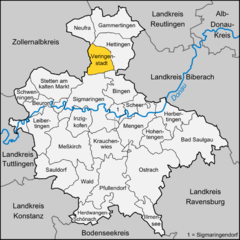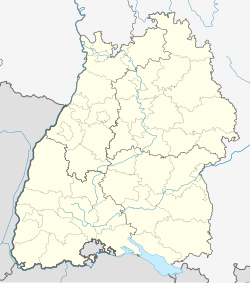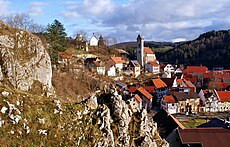
Sigmaringen is a town in southern Germany, in the state of Baden-Württemberg. Situated on the upper Danube, it is the capital of the Sigmaringen district.
Sigmaringen is a Landkreis (district) in the south of Baden-Württemberg, Germany. Neighboring districts are Reutlingen, Biberach, Ravensburg, Bodensee, Constance, Tuttlingen, and Zollernalbkreis.

The Province of Hohenzollern was a district of Prussia from 1850 to 1946. It was located in Swabia, the region of southern Germany that was the ancestral home of the House of Hohenzollern, to which the kings of Prussia belonged.

Upper Swabia is a region in Germany in the federal states of Baden-Württemberg and Bavaria. The name refers to the area between the Swabian Jura, Lake Constance and the Lech. Its counterpart is Lower Swabia (Niederschwaben), the region around Heilbronn.

Bad Saulgau is a town in the district of Sigmaringen, in Baden-Württemberg, Germany. It is situated 23 km east of Sigmaringen, and 27 km north of Ravensburg between the Danube and Lake Constance.

Neuenburg am Rhein is a town in the district Breisgau-Hochschwarzwald in Baden-Württemberg in southern Germany.

Gammertingen is a town in the district of Sigmaringen, in Baden-Württemberg, Germany. It is situated 18 km north of Sigmaringen.

Hettingen is a town in the district of Sigmaringen, in Baden-Württemberg, Germany. It is situated 14 km north of Sigmaringen. Hettingen absorbed the formerly independent municipality Inneringen in 1975.

Sigmaringen Castle was the princely castle and seat of government for the Princes of Hohenzollern-Sigmaringen. Situated in the Swabian Alb region of Baden-Württemberg, Germany, this castle dominates the skyline of the town of Sigmaringen. The castle was rebuilt following a fire in 1893, and only the towers of the earlier medieval fortress remain. Schloss Sigmaringen was a family estate of the Swabian Hohenzollern family, a cadet branch of the Hohenzollern family, from which the German Emperors and kings of Prussia came. During the closing months of World War II, Schloss Sigmaringen was briefly the seat of the Vichy French Government after France was liberated by the Allies. The castle and museums may be visited throughout the year, but only on guided tours. It is still owned by the Hohenzollern-Sigmaringen family, although they no longer reside there.
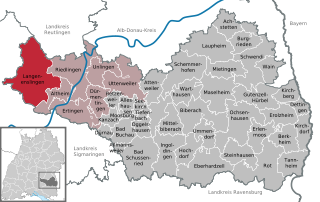
Langenenslingen is a municipality in the district of Biberach in Baden-Württemberg in Germany. It has a population close to 3,500.

Bingen is a municipality in the district of Sigmaringen in Baden-Württemberg in Germany.
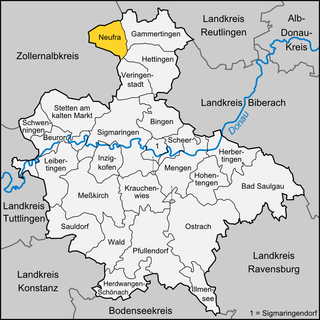
Neufra is a municipality in the district of Sigmaringen in Baden-Württemberg in Germany.
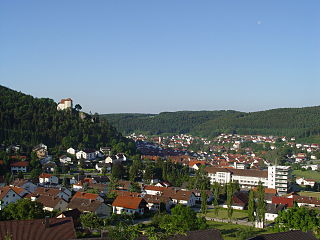
Straßberg is a municipality of the Zollernalb district of Baden-Württemberg, Germany.

Winterlingen is a municipality in the Zollernalbkreis district of Baden-Württemberg, Germany.

Amalie Zephyrine of Salm-Kyrburg, was a German noblewoman by birth member of the House of Salm in the Salm-Kyrburg branch and through her marriage she was Princess of Hohenzollern-Sigmaringen.

The Lauchert is a river in Baden-Württemberg, Germany, left tributary of the Danube. Its source is near Sonnenbühl, in the Swabian Alb. It is approx. 60 km long. It flows generally south through the small towns Gammertingen, Veringenstadt and Bingen. It flows into the Danube in Sigmaringendorf.

Hundersingen is a village within the municipality of Herbertingen and is part of the administrative district of Sigmaringen in the state of Baden-Württemberg, Germany. As of 2017, it had a population of 935. Current municipal administrator is Reinhold Eisele. Hundersingen has a nursery school and a primary school.

The Hohenzollerische Landesbahn (HzL) is the largest non-federally owned railway company in the German state of Baden-Württemberg after the Albtal-Verkehrs-Gesellschaft and Südwestdeutsche Verkehrs-Aktiengesellschaft. It has operates passenger and freight traffic since 1900. Its field of activity now extends to large parts of southern Baden-Württemberg.

The Engstingen–Sigmaringen railway is a branch line in Baden-Württemberg, Germany. It is owned by the owned by the Hohenzollerische Landesbahn (HzL). It runs from Engstingen via Gammertingen to Sigmaringen and is single track and non-electrified throughout.
